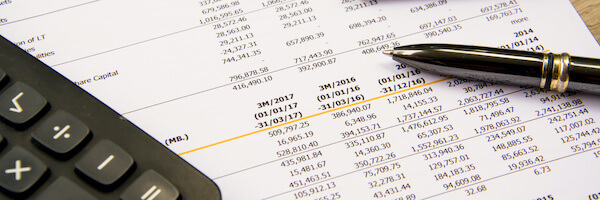
The stock market jargon often looks like it’s made up just to confuse new investors. Ratios are particularly scary, especially for those who aren’t fans of math.
Yet dividend yield ratio is one of the key terms that any investor should know. This financial metric is not that hard to calculate, and it can help you pick stocks that could generate a reliable cash flow.
In this article, we’ll define the dividend yield ratio in simple terms and compare it to the dividend payout ratio. We’ll also explore the finer details of good and bad yields.
How Dividend Yield Ratio Is Calculated
Imagine company A pays a dividend of $1 and company B pays $5. Which one is a better investment opportunity?
Well, just knowing the stock’s dividend isn’t of much help. You need to know at what price you can buy the stock.
That’s why investors use dividend yield ratio, or simply dividend yield: to understand how much income they get per share in percentage terms. That way, they can compare different companies with different share prices.
The dividend yield is calculated by dividing the dividend by the stock price. So the dividend yield formula is straightforward: Dividend yield ratio = dividend / stock price.
There is more than one number that you could plug as a “dividend.” Each option has its advantages and disadvantages:
- Total annual dividend per share from the latest financial statements: While this number is the most precise, it could become irrelevant if the company’s financial year is coming to end.
- Trailing dividend: This is the sum of all dividend payments paid in the last 12 months, aka TTM. Most financial websites provide this number and it’s good for estimating the yield in the future — unless there was a permanent dividend cut or increase within the 12 months.
- Latest quarterly dividend multiplied by four: This method uses the most recent dividend and is useful for future projections, yet it could give a distorted view if the latest dividend was temporarily increased, decreased, or suspended.
- Average dividend: This takes the average annual dividend over the past five years or other period and aims to give a more accurate long-term picture.
Which one should you use? Ideally all of them.
Corporate executives and their PR advisers might want to highlight figures that show the company in the best light. By looking at all the numbers, you could make a better comparison.
The share price is another part of the dividend yield ratio formula. Most financial websites simply use the current share price.
Yet if the price is now higher than the average over the past few months, this would result in a low dividend yield. And if the share price is lower, that would lead to a higher dividend yield.
These temporary price fluctuations could be misleading, so you might also want to recalculate the ratio using the average share price over a period of several months.
Most importantly, however, you should keep in mind that a high dividend yield isn’t necessarily a good sign.
High Dividend Yield: The Good and the Bad

As we have seen from the formula above, to produce a high dividend yield, a company should have a relatively high dividend and a low share price.
The “Bad” High Dividend Yield
A high and increasing dividend yield ratio could be a sign of a “value trap” or a “dividend yield trap.”
A relatively low share price could result in a high dividend yield.
The falling share price might reflect some fundamental problems. The industry could be in a long-term decline. Or maybe the company has too much debt. Or it might be losing market share to new disruptive technology.
For example, Xerox (NYSE: XRX) currently has a juicy dividend yield of over 4% as of August 2021. Yet this doesn’t tell the full story. For years, the maker of copiers struggled to adjust to the digital office world. While the company still generates enough profits to maintain its dividend, the pandemic has accelerated the shift to a paperless office and remote work. It’s not clear how Xerox would defend its positions, let alone grow in this environment.
For some companies, however, the lack of growth prospects is perfectly fine.
The “Good” High Dividend Yield
Instead of growth, some stocks offer stable and predictable cash flows.
Real estate investment trusts, or REITs, usually pay some of the highest dividend yields. These companies own and operate real estate that enables them to pay a stable dividend. Additionally, to maintain their advantageous tax status, most REITs must pay out 90% of their taxable income to shareholders.
While the average dividend yield for the S&P 500 companies is 1.33% as of August 2021, for REITs, it’s around 3% on average and could be much higher.
Meanwhile, nobody expects much growth from REITs’ share prices. Real estate valuations are already at record highs.
Another common group of dividend stocks are mature companies with stable cash flows. They have predictable and perhaps even somewhat boring businesses. Think utilities companies that have an average dividend yield of 3% as of August 2021. Nobody expects much growth from them either.
But long-term investors shouldn’t shun stocks with seemingly low dividend yields.
Is Low or Zero Dividend Yield Bad?
Companies have low dividend yields when their share price is high. And this is good.
For example, plenty of the so-called Dividend Aristocrats have yields below the S&P 500. These stocks have a history of increasing dividends for at least 25 years. That’s what most investors want. And this is reflected in their relatively higher share prices, which in turn leads to lower dividend yields. Investors are essentially paying for quality.
Meanwhile, some high-quality companies have zero dividend yield because they don’t pay dividends at all.
Amazon (NASDAQ:AMZN), Alphabet (NASDAQ:GOOGL), and Facebook (NASDAQ:FB) have never paid any dividend and instead reinvest all profits.
Lofty valuations of tech companies reflect their future growth potential and future dividend payments. Even if these companies are already big, investors expect them to become even bigger and eventually produce stable incomes.
This tradeoff between paying dividends and reinvesting into business ties to another metric: the dividend payout ratio.
Dividend Yield vs. Dividend Payout Ratio

It’s important to avoid confusing two terms that sound similar: dividend yield ratio and dividend payout ratio.
The dividend yield (defined above) allows you to compare dividends per share across different companies. Usually, investors use this ratio to compare companies in the same industry or sector.
The dividend payout ratio tells you the share of earnings a company directs to paying dividends. It’s calculated as the total amount of dividends divided by the net income. So the current market price is not relevant at all.
This financial ratio is usually defined in the company’s dividend policy or at least informally targeted by the company’s management. It’s useful for tracking dividends of the same company over years. That’s why investment banking analysts watch it closely.
On the other hand, the dividend payout ratio isn’t that relevant if you compare several companies. That’s because even competitors in the same sector usually have different balance sheet structures. For example, some companies have more debt. In that case, they wouldn’t be able to maintain a high payout ratio because they’ll need money to service debt. And that’s not bad if the debt is used for productive purposes.
Time to Search the Good Dividend Yield
As we’ve seen, the math behind the dividend yield ratio is not complicated. Yet different ways of calculating the dividend could provide different ratios. Share price fluctuations could also affect the number you get. We’ve then looked at how to evaluate the company’s dividend yield to find a “good” high yield. Finally, we’ve defined how to tell the dividend yield (useful for comparing several companies) from the dividend payout ratio (useful for tracking the same company).
Of course, when looking for dividend-paying stocks, you don’t have to go it alone. There are always opportunities in the market and spotting them takes practice. If you want to know which high-quality dividend stocks to add to your portfolio, sign up for Investors Alley’s Dividend Hunter PRO newsletter.





